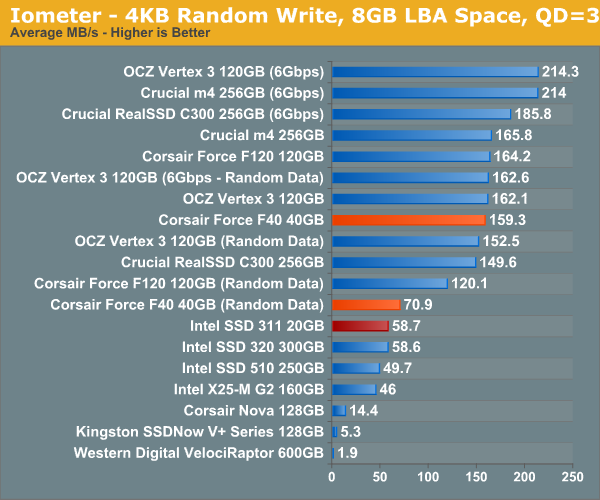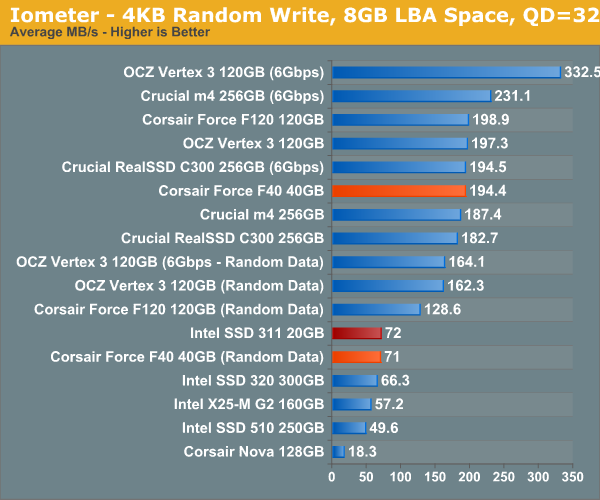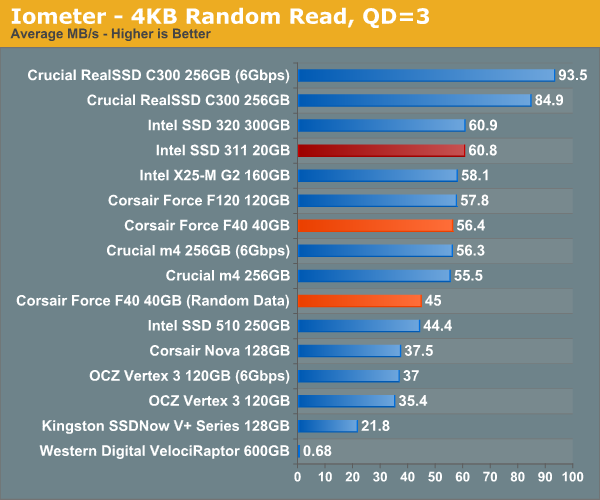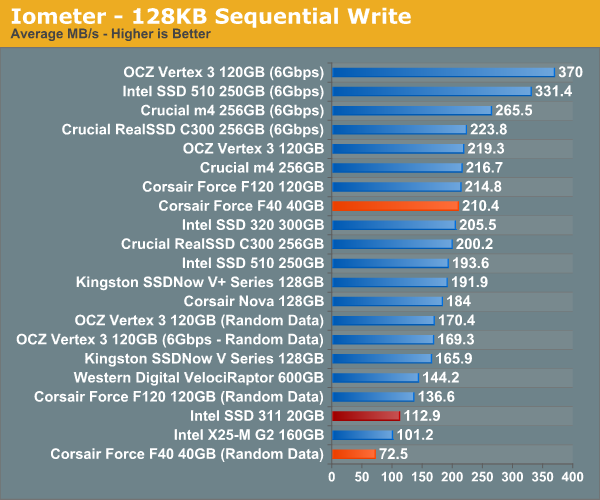Z68 SSD Caching with Corsair's F40 SandForce SSD
by Anand Lal Shimpi on May 13, 2011 3:06 AM ESTRandom/Sequential Read & Write Performance
To start with, let's look at how the Corsair Force F40 and Intel SSD 311 stack up. Remember that the F40 is based on SandForce's SF-1200 controller, meaning it gains its high performance by using real-time compression and deduplication techniques to reduce what it actually writes to NAND. Data that can easily be compressed is written as quickly as possible, while data that isn't as compressible goes by much slower. As a cache the drive is likely to encounter data from both camps, although Intel's SRT driver does filter out sequential file operations so large incompressible movies and images should be kept out of the cache altogether.
Peak sequential write performance is nearly double that of Intel's SSD 311. Toss incompressible (fully random) data at the drive however and it's noticeably slower. I'd say in practice the F40 is probably about the speed of the 311, perhaps a bit quicker in sequential writes.

For only having five NAND devices on board, Intel's SSD 311 boasts extremely high sequential read performance. At best the F40 equals it, but in reality the sequential read performance is likely a bit lower.

Random write performance is higher across the board, even with incompressible data. Random read/write performance is incredibly important for a cache, especially if most sequential data is kept off the cache to begin with. Things could be quite good for the F40 drive here.


Random read performance unfortunately doesn't look as good for the F40. Again, Intel's SSD 311 performs a lot like a X25-M G2, which happens to do very well in our random read test. At best the F40 is an equal performer, but at worst it's about 75% of the performance of the SSD 311.
Without a clear victory here, we'll likely see mixed results in our storage benchmark suite.











81 Comments
View All Comments
jordanclock - Friday, May 13, 2011 - link
I like the idea of this article and it starts providing some extra data that was asked for in the original review: What about other SSDs? Could we get some more SSDs tested with SRT? I'm not expecting Vertex 3s, but some "older" SSDs like the F40 that would likely be replaced soon.MrSpadge - Friday, May 13, 2011 - link
Currently Anand tested 3 mid- to high performance SSDs and I think this gives us a pretty good picture overall. However, if another one was tested I'd want the 64 GB Agility 3 and/or Solid 3. Well, a proper review of them would be very nice anyway ;)MrS
Cow86 - Friday, May 13, 2011 - link
Yea I was thinking the same thing...they supposedly perform a lot better, while still being reasonably affordable for the 60GB drives (~110 euro's here). Maybe they'd be the ultimate cache at a reasonable price point? Either way would love a review of those as well, vertex 3 is staying rather expensive :(jebo - Friday, May 13, 2011 - link
I agree that the Agility 3 and Solid 3 look very promising.therealnickdanger - Friday, May 13, 2011 - link
Plus, SRT works with drives up to 64GB, so it seems worth it to test a drive of that size. I imagine there are many users (such as myself) that have older Intel 80GB, Indilix 64GB, or SandForce SF1200/1500 64GB drives that will soon be replaced with faster 6Gbps drives.I would imagine that you could a drive of any size, especially the larger ~120GB SSDs that offer significant speed advantages over the 64GB models. SRT would limit the usable cache to 64GB, but it would still be interesting to see...
*wink**hint*
Boissez - Friday, May 13, 2011 - link
Yup - Here's another vote for that article. I have an 'old' 60GB agility 2 boot drive and a Z68 board on it's way. Question now is whether I keep it as boot drive or whether I take a performance hit and use it as cache. This article comes close to answering it yet Anandtech's own SSD workload benchmarks (which are the most interesting IMO) does not include the F40's numbers.GullLars - Tuesday, May 24, 2011 - link
If you can fit your OS and core apps/games on your agility 2, it's a no-brainer, keep it as you have. If you have a lot of apps and games you have had on HDDs and use often, you could concider trying it as cache.I have 3 computers with 32GB boot drives (1 laptop, HTPC, and a donated SSD to my fathers computer), and all of them get by fine with that with a little bit of management. You could concider using 30GB for caching and 30GB for OS + core apps, getting full SSD speed on the stuff you use the most, and have cache help out on game loads and more seldom used apps.
Mr Perfect - Friday, May 13, 2011 - link
That's what I'm thinking too. Get yourself the largest, fastest cache you can and see what happens. :) Currently that's looking like a 64GB Agility 3 or Solid 3.samsp99 - Friday, May 13, 2011 - link
I was just asking myself this very question...genji256 - Friday, May 13, 2011 - link
I'm confused. If the 311 performed better on the second run ("Intel 311 - Run 1" in your table), shouldn't that mean that the cache was large enough to store the data for all the applications (since they all ran during the first run)? If so, why would there suddenly be data evicted from the cache between the second and third run ("Intel 311 - Run 1" and "Intel 311 - Run 2" respectively)?